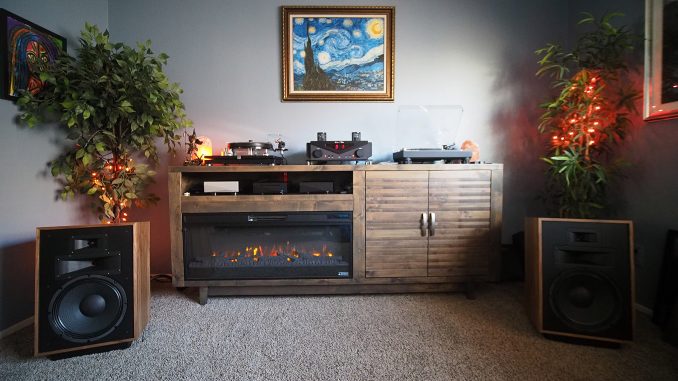
HiFi: Innuos Zen Mini MKIII Review with Phoenix USB Re-Clocker and LSPU.
By Steve Huff
Hello all fans of HiFi Audio. Today I will be posting another review of two products in HiFi that have really made me appreciate what a digital streamer setup under $5k can really do. For the last few weeks I have been running an Innuos Zen Mini MKIII streamer with the brand new Innuos Phoenix USB Re-Clocker and it has been an enjoyable experience.
My local audio dealer Arizona Hi-Fi let me take home both to demo (and I did buy both of these pieces after I evaluated them and compared them to what I had on hand, as well as other options). All details will be talked about below but today we are in the age of STREAMING. Using our phones, our tablets or our computers we can now stream any music we want to listen to from a vast library of choices. Streaming services allow us to sign up and start listening to music NOW.
Sure, we can still go to the old ways…Analog with Vinyl and Tape or Digital with CD’s, but streaming is what it is all about today and what we have here is a small, powerhouse of n audio product. It combines a streamer with a CD ripper so you can burn and store your CD’s, hence creating a server. This little box also has a built in DAC (though you can expand the performance with an external high quality DAC). All of this for $1250 and yes, it is capable of streaming high res formats.
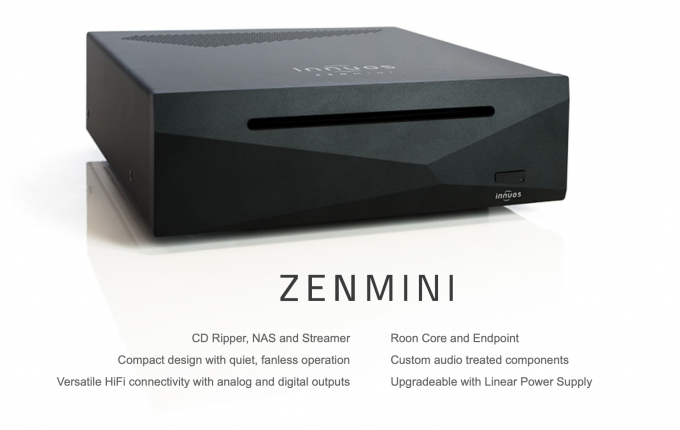
Recently I wrote up a review of the fantastic Bluesound Node 2i, which is the most streamer most of us will ever need. I mean, if you are not an obsessive audiophile or do not critically listen from your sweet spot, the Node 2i is superb and a true bang for the buck. That streamer does high resolution, it looks nice, and doesn’t cost an arm and a leg. At $550 or so, the Node 2i is highly recommended. I own one. I also now have a Zen Mini MKIII in house. This is a good thing as it has allowed me to compare them all side by side in my 2 channel HIFI system.
The kicker is that they all are different in the way they present the sound and yes, even when using an external DAC.
Today as of right now, Feb 2020, my audio system is comprised of the following:
12X13 Dedicated Room. (this has the most effect on your sound)
Vinnie Rossi L2i SE Integrated Amp with L2 DAC and Phono Stage Module.
Klipsch Heresy IV Speakers (I have other speakers I rotate in as well)
Nordost Blue Heaven full Loom.
Michell TecnoDeck with Dynavector 10X5 Cartridge.
Zen Mini MKIII Streamer/Server running Roon (A $1250 Ripper/Streamer/Server)
Innuos Linear Power Supply for the Mini MK III (gives body and more foundation to the sound)
(on loan) Innuos Phoenix USB Re-Clocker (A $3149 USB Purifier that expands air, soundstage and delicacy)
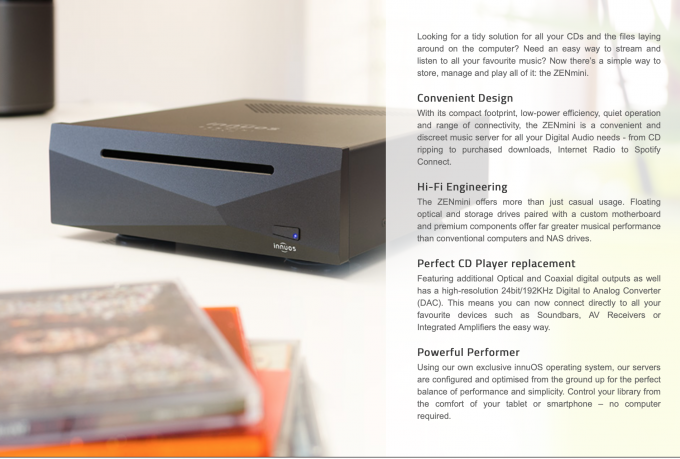
First things First
So after living with the little Zen Mini MKIII for just a few days (while comparing it to other streamers), I ordered one. That was a stock, bare bones Zen Mini III on its own without the external linear power supply or Phoenix USB Re-Clocker. I did order the power supply for the Mini III as well. The Mini III arrived within a week, and I have been waiting on the power supply now for around 4 weeks (arrived while writing so I will talk about this below)!
So this review was done after listening daily for weeks with just the Zen Mini and then the Zen with the Phoenix USB and then with ALL THREE, adding in the Linear Power Supply. A three box setup. The Zen Mini has four USB outputs and one COAX output, both meant to go direct into a DAC. If you want, you can use the RCA outs and use the DAC inside the Mini III. I tried this and it was actually sounding nice but the sky is the limit as you can hook this little guy up to any DAC you can get your hands on. This will improve the sound, sometimes in a dramatic way. I have used it with COAX and USB and prefer USB, so that is how mine is set up and how I listened for this review.
I first compared the little $1249 Zen Mini III all by itself against the Bluesound Node 2i which is $549, both going into my Vinnie Rossi L2 DAC. I expected them to bring the same exact sound in my system as they are sending the same signal to the same DAC.
I was wrong.
I am feeding only the digital signal from the Zen Mini III via USB into my Vinnie Rossi L2i SE DAC which is a SUPERB $3500 DAC module. Here the sound is detailed, airy, wide and tall but a little leaner than the Bluesound.
The Bluesound going into my DAC via a Nordost Heimdall COAX (can’t use USB with the Bluesound) gives off a big large sound with a wide soundstage and a warm leaning sound. It sounds great and again, is a streamer for almost all of us, meaning most will never need more than this. It has rhythm and pace and allows the DAC in my Rossi to do its job all while providing a great app to control it all.
That is what it is all about after all isn’t it? Getting the bits to the DAC? Well, yes but between the Bluesound Node, the Sonos Connect and the Zen Mini MKIII each of them sounded different.
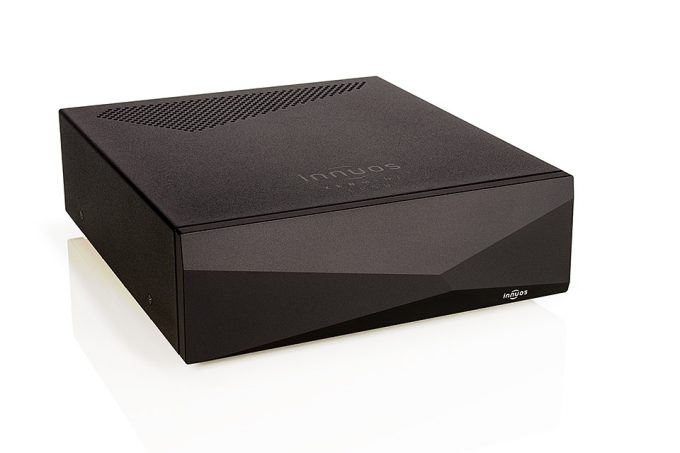
Before I get more into the details of that let me back up a little and talk about what the Zen Mini MKIII actually is.
The Zen Mini MKIII is a music streamer and server and offers much more than the Bluesound does. It has a CD slot on the front and allows you to rip your CD collection in a very easy and hassle free way. Simply place a CD into the slot and the Mini III automatically will suck it in and will start to rip it to the internal hard dive. After that it will be available to stream right from your phone or tablet or computer. You can simply go to my.innuos.com and see your ripped music collection and play from there if you are no going to be doing any streaming.
As for storage, you can pick your hard drive size when you order an Innuos streamer. I chose the lowest 1TB size as I no longer have many CD’s and all of what I do own will easily fit to the internal 1TB drive. You can go as high as 4TB. You can choose to burn a CD fast or if you want it to be more quiet you can choose a more silent option if listening while ripping. It’s easy, quick and pain free.
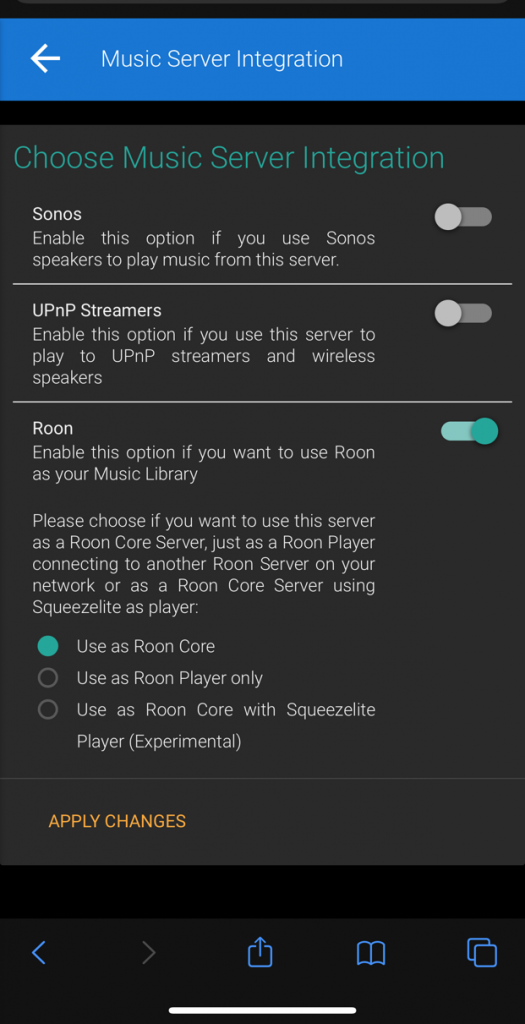
The Zen Mini III also allows you to stream using Tidal, Qobuz and to some extent Spotify. It’s not just a server, it’s also a streamer. Let me explain.
The Zen Mini III has to be set up when you first install it, just like any streamer. For me it took about 5 minutes. I turned it on, hooked it up to my ethernet (which is a must) and then pointed my phones browser to my.innuos.com. As soon as I did I was able to see all settings, change all settings and set up the device. When you are in this interface you can set up your Innuos streamer to use ROON or UPnP. If you choose ROON you will need to sign up for and download ROON.
Roon allows you to manage all of your music in an elegant, easy way. It also allows you to stream from Tidal or Qobuz and the interface is the best and most complex that I have experienced in any music streaming software. At $119 per year or $499 for a lifetime license it’s not cheap but it is oh so worth it if you stream most of your music. I did the year option but I wish I would have splurged for the lifetime actually (UPDATE: I have since purchased the lifetime option). Now that I have been using ROON, I can not go back to life without it!
For my Mini MKIII I use it as a ROON core but also tried the UPnP setup within the Innuos setup. When you set it up in this way you can download and use the iPeng app if on iOS.
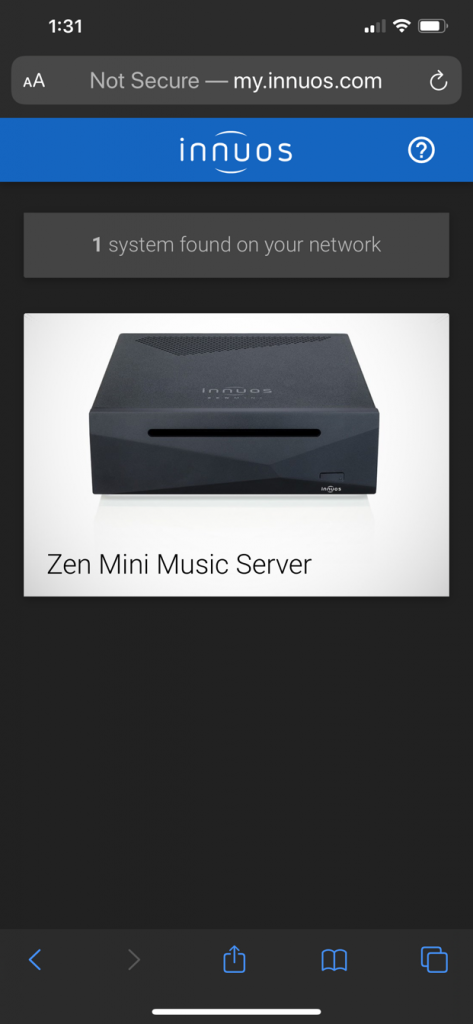
I tried both but did not like the iPeng experience at all. I had issues and I also found the app to not be anywhere as nice as ROON when it comes to user experience. I ultimately setup my Zen Mini as a ROON core which is also a huge plus of the Innuos. I can not do this with the Node 2i or the old Sonos and is part of why it was so much more attractive to me as a streaming solution.
This means I can stream direct from my phone, laptop or tablet using the ROON app or software. No computer needed. No core needed as it is its own core. (UPDATE 5/2020: I will say that over time I started seeing a serious lag time using the Zen as a ROON core, and freeze ups as well)
Just to note, I also demoed the more expensive and beautiful Zenith MKIII streamer from Innuos before I purchased the Mini III. More on that later.
So right off the bat the Innuos is a more refined product than the Bluesound as it allows you to use it as a ROON core, it has a CD ripper for your old CD’s and it does have a different sound, of which I will describe below.
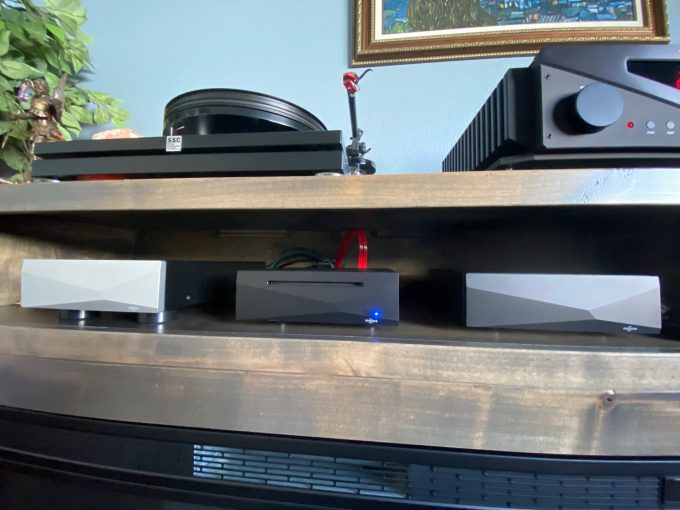
The Zen Mini MKIII vs the Bluesound Node 2i vs a modded Sonos Connect (Magna HiFi).
Having years of experience with the Sonos connect, and many months with the Bluesound Node 2i I know these pieces very well. The Sonos going direct into my DAC via COAX was different from the sound of the Bluesound Node 2i using COAX into my DAC. How could these be? Bits are Bits right? Well, obviously not. The Zen Mini III sounds different yet again, and when you add the Phoenix to it, it is pretty noticeable, instantly, to these ears.
The Bluesound 2i offers up a slightly warm presentation. Not the last word in detail but its very musical. Over time it can start to sound dark once you hear other sources. If you never compared the 2i to anything else you can be happy forever with it ; )
The Magna HiFi modded Sonos Connect in the same setup with the same cable and music offers up a leaner brighter presentation. Less mid bass and deep bass but much more detail in the upper end. More air, but when compared to the Node 2i it seems something is missing, and it is. The MidBass is sucked in rather than pushed out. Again, if all you heard was this and never compared it to anything you could be happy as our ears will adjust and get used to the sound. But it will be a matter of time until you want more.
The Zen Mini III on its own is completely different from the Bluesound 2i sound. Where the 2i was warm, full in the mid bass and gentle on the treble the stock all by itself Zen Mini III went the other way. There is much more air, detail and soundstage expansion. Imaging is more precise as it’s those higher registries that really bring out the sound of certain instruments. At first I was not sure I was in love with the sound as the Node 2i was sounding richer and more full and the Zen a little thinner in the mids. After another side by side it was obvious that the Zen Mini MKIII was offering up a more layered and detailed presentation. It was more “audiophile” I can say, more airy. I did notice the bass to be a bit weaker than when I demoed the Zenith III, the more expensive streamer from Innuos. Also, if I can be picky I will say there was an ever so slight digital edge to the sound.
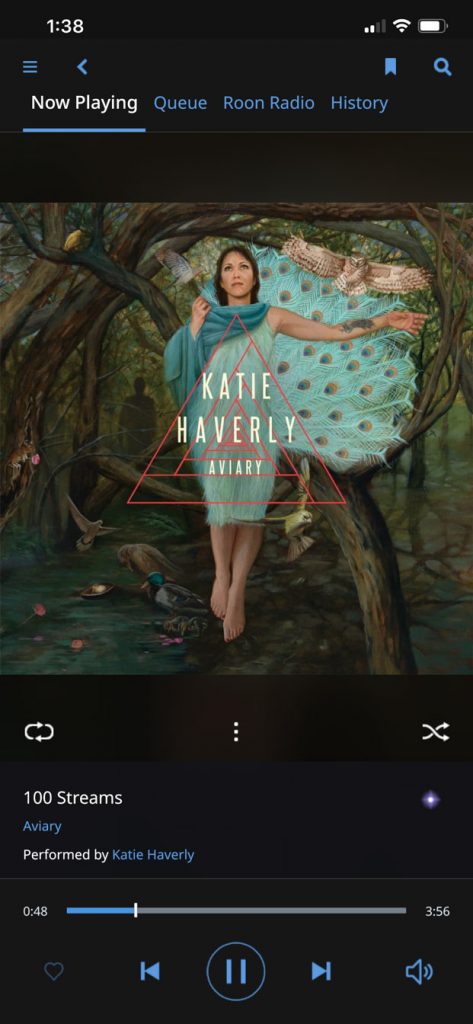
I then added the Innuos Phoenix USB to the Mini III. HOLY SMOKES!
The sound instantly expanded to the wall boundaries. The sound smoothed out and any sign of digital grain or glare was gone. The sound was smooth, silky, detailed, expansive, and the bass improved a few notches. The sound was fuller, bigger, had more air and space going on and still retained the detail and imaging properties. To me, this sounded better than the all by itself Innuos Zenith MKIII which comes in at around the same price as the Mini and Phoenix combo. Keep in mind, this is in my system, my room. Your results my vary. Just because something is more expensive does not always make it better. Rather, it will be “different”. In my case the little Zen Mini MKIII won easily when the Phoenix USB re-clocker was added. I can only imagine what this Phoenix would do to the Zenith III.
Some will say this is not possible, as again…bits are bits. Lol, well, something is improving the sound and it should as the Phoenix also has a high end power supply in addition to the re-clocker. It’s also quite heavy and hefty.
I listened for 5 days with the Phoenix and the Zen Mini III. I was in heaven as the sound was just so realistic, and real. I removed the Phoenix to see if I cold hear a difference and WHAT A DIFFERENCE INSTANTLY! When removed the sound flattened, shrunk and sounded more digital and I now was hearing a slight digital grain. What the heck?!?!?
When the Phoenix went back in, it was like magic. There it was…huge, enveloping, full, smooth, detailed and with such a realistic sound. Imaging was precise and downright magical with some music. There was added space, 3 dimensionality. I could not believe it really so I took it back out. Instant flattening.
The interesting thing is I did not notice many of these things until I heard the Phoenix in my system.
There is much more to this “re-clocker” than just re-clocking the USB signal.
Here is what Innuos says the Phoenix does for your music system and this is direct from Innuos:
“The PhoenixUSB does mainly three things:
1. It regulates the 5V line from the source, helping remove some noise from the source itself
2. It replaces the 5V power by one of the included Statement-level linear power supplies existing on the PhoenixUSB
3. It reclocks the USB signal with a very high-end OCXO clock, which is powered by its own power supply. Do not confuse this with the clocking for the audio signal, we are not touching the audio signal at all. We are reclocking the USB commnunication between the source and the DAC. You could even connect a USB drive to the PhoenixUSB if you like, although that probably would not make sense – this is just to illustrate the PhoenixUSB does not work at the audio level but at the USB protocol level.
If you can hear a difference? Given all the feedback we had so far and the numerous shows we have done A/B, it is 100% guaranteed you will hear the difference right in the first seconds of hearing a track. it’s not a subtle change…
Hope this helps.
Nuno Vitorino
Director”
So there you have it, right from Innuos. I will say that Nuno is correct in what he says, I validated here in my own system. What it does is not subtle and honestly, I do not care in the slightest on how it achieves this. I just know what it does for my music enjoyment. Again, it makes an improvement to the flow, the refinement, the details, and bass. It adds more air, space and 3D imaging is improved.
The sound emanating from my Klipsch Heresy IV (my speaker of the year so far for 2020) is quite frankly, unreal at times with the Phoenix and Zen Mini III. Innuos says when you add the Phoenix and the External Power Supply to the Mini III you will have a pretty serious streaming setup. I agree.
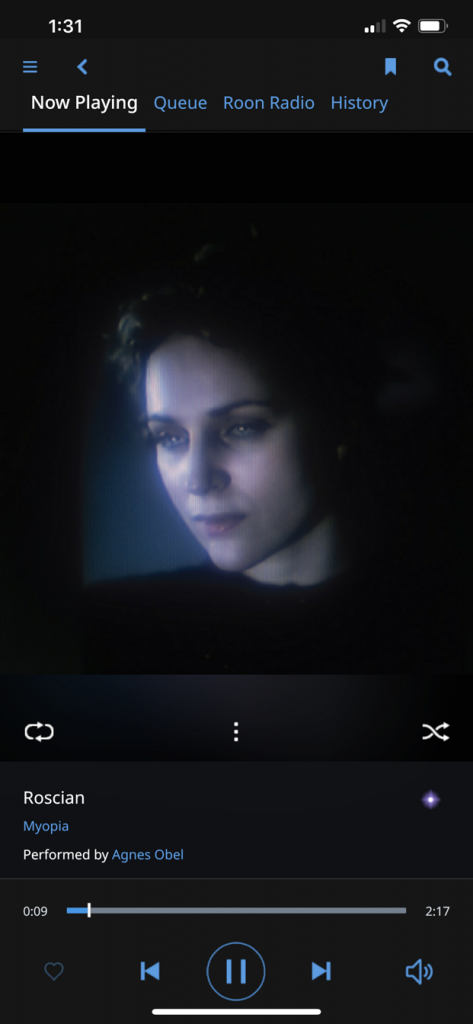
THE POWER SUPPLY ARRIVES!
As I was mid review the external power supply arrived for my Zen Mini III. This has allowed me to now hear what all three of these sound like together. The Mini III, the Power Supply and the Phoenix. Retail for these three come in at around just over $5k, which is slightly more than a Zenith III would be by itself. Of course you can just use the Mini on its own, but by adding these pieces it upgrades you each step of the way. The beauty is you can do this over time if the wallet is a little thin.
After setting it all up with the power supply added and then pressing play I heard yet another noticeable striking difference. Now the sound had more weight behind it. The bass performance became quite a bit better with more meat on the bones so to speak. It made for a healthier presentation and was more immediate and tangible. It sounded bigger still and more refined and mature. With all three of these together it creates quite the digital presentation as it doesn’t sound digital at all.It may be the finest digital sound I have had here in my room to date, but it should be as this far outclasses my old Sonos and the Bluesound in Cost. Is it worth the cost difference? I mean, I have a $549 Bluesound Node 2i here and the Innuos system which will cost over $5k USD. That’s a difference of $4500. Not worth it for most, but for some, it may be the digital end game you have been searching for.
NOTE: While the sound is gorgeous, I found myself having to restart the Zen Mini III almost daily as when I would open ROON it would no longer find the core, which was the Zen. After a reboot it would be fine but that took 2-3 minutes each time.
So is it worth it? Well, for me, yes. For you? That is hard to say. If you listen critically, if you have a sweet spot, if you want a more refined expansive sound, if you want something special that you know is world class to go with your higher end system then yes, it is worth it. If you have a higher end system then something like this can really make a difference when compared to a Sonos or a Node.
For me it was the Roon integration that sealed the deal but now that I have heard the Zen Mini III on its own, and then with the Phoenix and the LSPU, I heard the improvements every time I added something in. To be sure of this I took out the Power Supply and Phoenix. Wow. I mean, this is a night and day difference. The sound collapses when removing the Phoenix and Power Supply. Adding back in the power supply adds that meat, and some warmth which is just about right. Adding the Phoenix just makes everything much more refined. There is more air, more 3D, and it somehow makes the sound more Human. Real. Emotional.
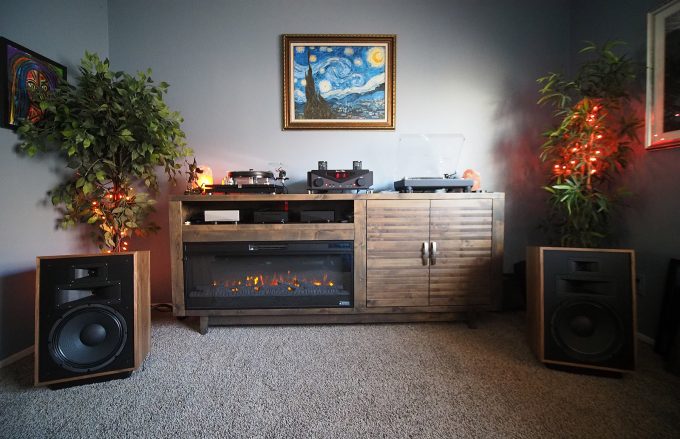
LISTENING NOTES w/Mini, LSPU, Phoenix
LANDSLIDE – Fleetwood Mac – 24/96 Tidal Stream. This is a good recording and I have heard this so many times, in every system I have owned. This is as good as I have ever heard it. The acoustic guitars are so immediate, rich and layered. Stevie Nick’s voice is dead center with a warmth and emotion that I do not always hear. Imaging is superb and separation of instruments is just right. The music flows and if I close my eyes I can hear acoustic instruments all around, mostly to the sides while the vocals float in the middle of the room. Magic.
QUE SERA SERA – Pink Martini – CD RIP to Mini III – This is a CD I have had forever. I ripped it in the Mini III and the sound here is a tad lighter than the Fleetwood Mac selection above. Well, at first it is. It stars out gently with soft vocals and at around 1:50 in it kicks in with a barrage of instruments and sounds that only grows in intensity. Here it sounds warm, big, rich and full with that polished sound that is just so refined. No hint of digital glare. At 2:45 I start to hear things I have never heard in this song, and this is what makes this setup so wonderful.
GHOSTTOWN – Madonna – Tidal FLAC – While I am not a huge Madonna fan these days I will say that this song and album (Rebel Heart) sounds fantastic here. Big sound with a HUGE DEEP bass yet the bass is solid as a boulder. It doesn’t flap or flop. Instead, it hits me in the chest when I turn it up. These Heresy IV speakers continue to shock me with just how good they are. This system is just portraying MUSIC. Madonnas voice is center and there is such a background silence and lack of noise, a times it can get haunting. This is one to turn up.
OVER YOU – ZZTOP – Tidal FLAC – This track is usually a bit hard sounding, so I wanted to hear it again with this setup. The recording is RAW and on some systems it can sound flat and harsh. Heck, on most systems I have heard this one it is a bit aggressive. Here it still has that raw edge but it’s again, much more refined. Smoother, more pleasing and more enjoyable. Billy Gibbons vocals are deep, direct and in your face while his guitar solo just melts from the speakers. Best I have heard this track.
SWAY – DIANA KRALL – Tidal FLAC – Ok, get your glass of whiskey, turn out the lights and turn it up. This track will bring you Diana into your room. It’s seductive, sexy and intimate. Sounds like she is singing just for me and her vocals are so direct and in the room. When I listened to this without the power supply it had a lighter presentation with a crisper sound to the vocal. With the power supply added it just gets more realistic. The smoky voice of Diana Krall is smooth as silk here while instruments are gently playing and presented in a rich full way, with a big tall and wide soundstage. Yes TALL.
YOU WANT IT DARKER – Qobuz 24 Bit Stream – I have heard this song on many systems. I have never heard it this good. The way the Innuos deals with Leonard’s voice here is magical. Yes, the way this was recorded will bring Leonard right to you in most systems but here, again, human, real, right there with you. Textures in his voice appear that I never noticed before and when the singers in the back chime in they are more separated than I have ever heard them. They propel out to the sides but are totally separate. Leonard sings to you dead center and the music fills the room. I have never heard this track sound like this. Amazing.

CONCLUSION
At the end of the day there are differences in music streamers when we start to go into the higher end, even if using an external DAC. One thing I need to mention is that the Zen Mini MKIII has a built in DAC if you do not have or use an external. It’s an all in one piece, and you can start with the streamer and upgrade it in many ways as you move along your audio journey. Add a DAC later. Add the power supply. Add the Phoenix. It’s a streamer that can seriously grow with you and will not be obsolete as it will always sound just as beautiful as it does now. If you can swing 2X the cost of a Bluesound Node 2i, I would suggest looking at the Zen Mini III and then adding to it later as you can but I do prefer the DAC inside of the Node 2i over the DAC inside of the Mini. On their own, I prefer the Node 2i. But when you add to the Mini, that is when you can take it up a few levels in performance.
As it is now, the Zen Mini III with LSPU and the Phoenix is simply delicious in my system. Now of course the Innuos Statement would be the TRUE end game but for 1/3 the cost, the Mini combo is something one should not take lightly.
I do have to state again that with all three pieces, and using the Zen as a Roon core, it can get sluggish when browsing and playing music. I have had it freeze up, and have had Roon no longer recognize the Zen..on a daily basis I need to restart the Zen. This adds frustration, I admit but the sound here is just on a new level.
As for the Phoenix, I know many are skeptical of pieces like this, especially at the cost of over $3k but I suggest to go out and read opinions from actual customers who have bought or heard the Innuos Phoenix. You will see rave after rave. It’s the real deal. As I said, I do not care how it does what it does…just that it does. It’s all about the music for me, not the specs or details. Just the music.
I bought mine from Arizona Hi-Fi. Located in central uptown Phoenix they offer some of the coolest gear in town. Tubes, analog, digital, speakers, amps, tweaks, etc. Highly recommended you stop in or give them a call if you are looking for Innuos products!



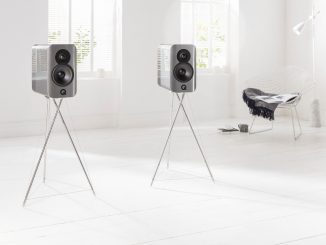
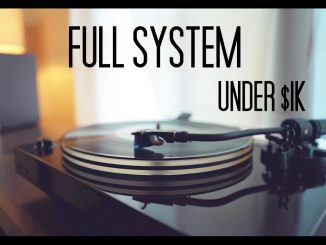
Hey John,
Sounds like you have a great setup! I have NOT tried the Phoenix on anything other than the Mini III so I can not say if it will have the same effect when used with the Aurender. If I were you and looking into this, I would go with the Chord M-Scaler since you have the Qutest DAC. That combo should be stunning!
Stevo gotta ask all this gear : cameras, hifi is all about you.
But where does Debbie your far better half have her life.
I know your site is now Steve huff Reviews, where once it was Steve Huff Photo.
But I miss the photo part.
Remember the good old days?
I think you should start reviewing film cameras. That is where the kids are at (being serious here). There are thousands and thousands of cameras dirt cheap that you can review so peeps out there looking for something nice have an idea of what they are getting into.
So you don’t have to start with Leica Ms, or Nikon F6. But something like a Chinon Bellami. Pentax MX. Fuji Work Project. Olympus XA etc.
You can still link to ebay, Amazon etc and even link to your favorite vendors by saying something like “want the modern equivalent in digital? Check this out” etc etc link to Sony/Fuji/Nikon etc product.
You could even link to the shop that does your Developing and scanning if you don’t do that yourself! There are a bunch of great places out there. Plus you can scan with your digicam, it is so easy now with products like negativelabpro.com, the Nikon ES-2 film holder etc.
One camera, one roll of film, post 10 pics from it. $30-$50 for a review. You can even sell it at the end of the review!
Hi Steve, another great review. So now I am in a pickle. I am running a Aurender Music Server going USB out to my Chord Qutest. If you had to choose would you get the Pheonix USB reclocker or for a wee bit more money…the Chord Mscaler to run into the Qutest. I have heard the Mscaler and Qutest pairing is mind blowing but now I am wondering if the Phoenix reclocker might have more impact….your thoughts ??
There is no re, up or down sampling going on here or with any of the streamers tested, and all are using the same “bits” from the source, and all sound very different going into the same DAC. So in this case, none of that is happening. Thank you.
With audio, it’s all about the room ; )
Bit are bit,
but not the same bits for all streamers not speaking of your test)
Some downsample HI-RES
other ovar sample to HI-RES whatever the original signal.
The signal sent to the DAC is not always the original signal
It is nice to see you having so much fun exploring new audio gear. With cameras, people often say it’s all about the photographer not the camera. In the audio world, I’ve never heard anyone say it’s all about the listener, not the gear. That is not to say that listeners don’t have sonic preferences and differences in their hearing ability. However, with audio gear, there is an excitement that comes from better equipment that going from 24 to 42 megapixels can’t provide at least for me. It is great to see more high quality streaming becoming available (mp3 is pretty bad).
Hi Steve,
as for the Roon lifetime membership – it is now 699, up from 499. I think they will refund your current annual subscription (the “unused” months) if you choose to go lifetime.
And fwiw, I wouldn’t call Roon “complex” – rather “comprehensive”.